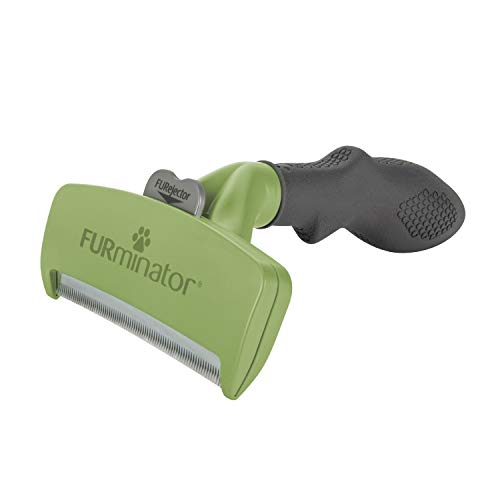How To Take Care Of A Husky Puppy: A First-Time Owner’s Guide
How to take care of a Husky puppy: a first-time owner’s guide by Dr. Sarah Ochoa, DVM
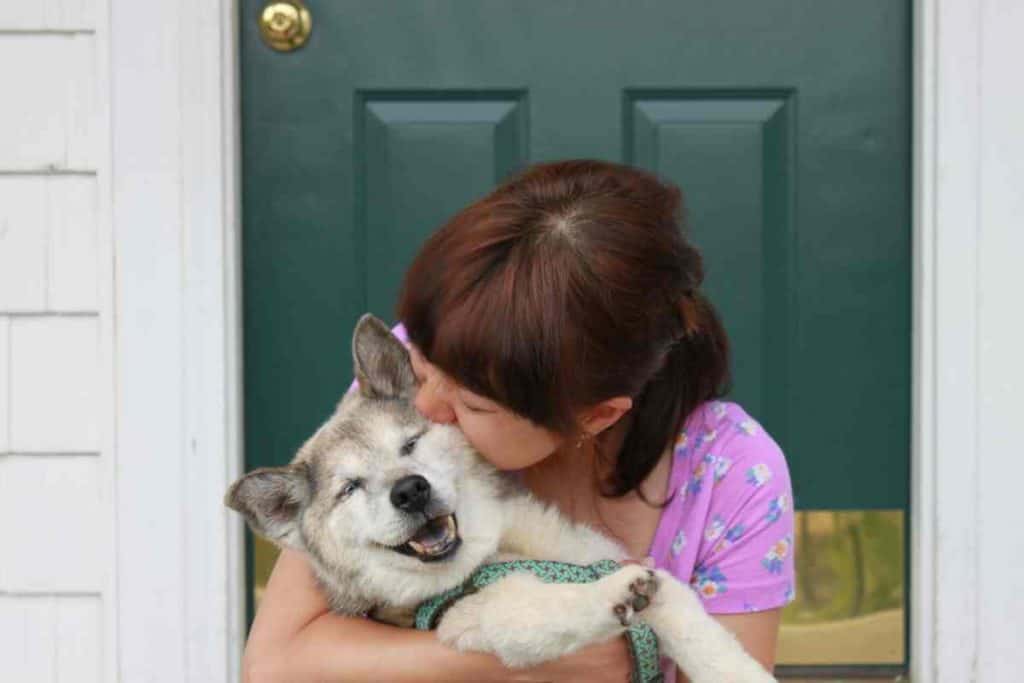
Have you just gotten your first Husky puppy? There are many things a first-time owner needs to know about to make sure that your new Husky puppy is happy and healthy.
This article will serve a complete guide on how to take care of your new Husky puppy.
How To Take Care Of A Husky Puppy?
There are some things that you need to do to make sure that your Husky puppy is healthy and happy.
- Visits to the Vet for vaccines and spay or neuter
- A high-quality diet
- Potty training and Socialization
- Behavioral Training
- Watching for Signs of Illness
- Grooming your Husky
By following these simple steps, your Husky puppy will be on the right track for a long, happy, and healthy life.
This article will provide you all the needed resources when you have a question on how to raise your Husky puppy.
A Visit to the Vet
When you get your Husky, you will want to schedule an appointment for them at your veterinary office. Your vet will examine your Husky puppy and make sure that they are healthy.
They will review what vaccines the breeder may have given your Husky.
Most of the time, your vet will check your Husky’s stool for worms and get started on a vaccine schedule.
This is a standard schedule that most vets follow for vaccines.
When do I need to get my Husky puppy vaccinated?
- At six weeks: your Husky will receive a Distemper/Parvo/Parainfluenza vaccine and a Kennel Cough vaccine. The breeder usually does this before you get your Husky puppy.
- At nine weeks: your Husky will receive a booster of their Distemper/Parvo/Parainfluenza vaccine and a Kennel Cough vaccine.
- At 12 weeks: your Husky will receive a Distemper/Parvo/Parainfluenza vaccine, a Leptospirosis vaccine, and a Canine Influenza vaccine
- At 15 to 16 weeks: your Husky will receive a Distemper/Parvo/Parainfluenza vaccine, Leptospirosis vaccine, Canine Influenza vaccine, and a Rabies vaccine.
During these vet appointments, your vet may also check a fecal sample to look for worms in your Husky’s stool.
Many of these worms are very small, but some you can see in their stool without a microscope.
If you see any worms in your Husky’s stool, make sure to let your vet know.
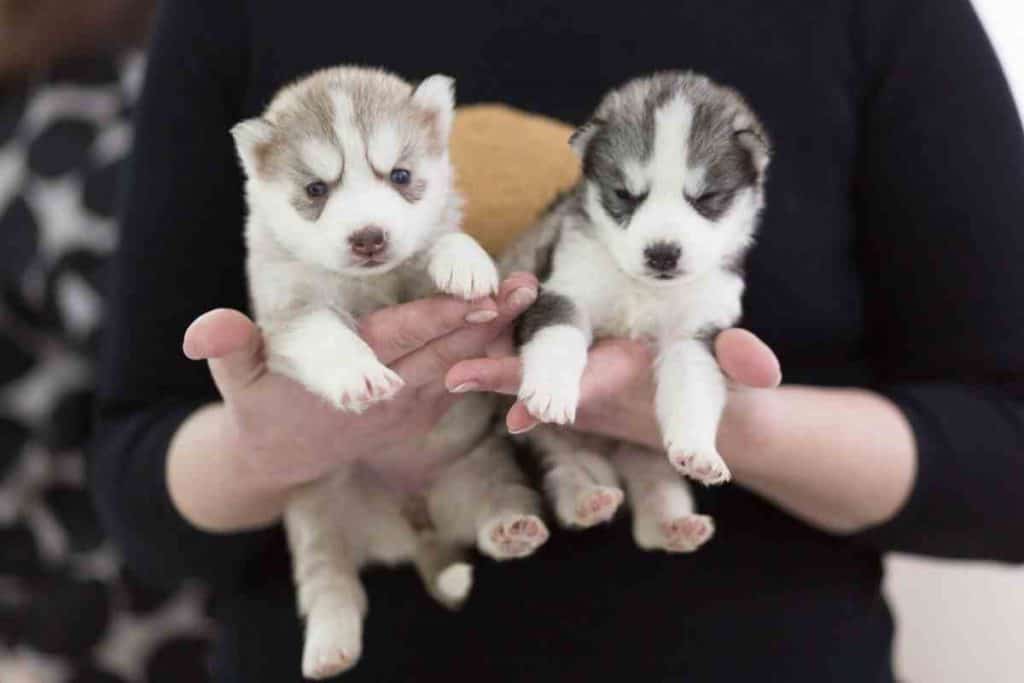
They can give your Husky puppy medication to eliminate these nasty worms. Not only will your Husky need vaccines, but they will also need heartworm, flea, and tick prevention.
All these parasites can cause many health problems in your Husky, some of which can be fatal.
When do I need to get my Husky Spayed or Neutered?
Most vets recommend spaying or neutering your Husky puppy around six months old. Some people will wait until their Husky is a little older before spaying and neutering to allow their Husky to mature a little bit more.
If you want your male Husky to have a more masculine look waiting until they are fully mature around 12 to 18 months is best. Your veterinarian can discuss the many pros and cons of spaying your dog around 6-month vs. waiting until they are older.
The American Animal Hospital Association (AAHA) recommended spaying and neutering before your Husky’s first heat cycle.
This reduces the chance of mammary tumors in females and eliminates testicular cancer in males.
By not spaying your Husky, you are risking them developing a pyometra. Pyometra is an infection in the uterus that can be fatal if not treated early enough.
Husky puppies recover from their spay or neuter procedure very quickly, whereas an older dog may take a few days. Surgery on your young Husky puppy will help them from developing significant problems later in life.
While puppies can be adorable, overbreeding dogs has caused a lot of pets to end up in shelters and not in a loving home.
Providing High-Quality Dog Food
You will need to get high-quality dog food for your Husky. For your Husky to stay healthy, your Husky will need proper nutrition. Not all dog food will contain the needed protein and fats that are necessary for your Husky puppy’s diet.
There are many wonderful diets on the market. Most Husky puppies will need to be fed food that is higher in protein than adult food. When looking for a diet for your Husky, you should try to find one that has a protein content of at least 22%.
You should also look at all the ingredient lists on the back of the bag. The first ingredient should be protein. It is even better if it is the whole protein and not a protein meal.
Once your Husky puppy is almost fully grown, you can switch to adult food. This is usually eight months to 1 year of age. Most Huskies will stay on their adult diet until they are about 7 years, they will then switch to a senior diet. Your veterinarian can recommend help you pick out one of the many great brands of dog food.
How much to feed a Husky Puppy?
Most vets recommend following the feeding instructions that are on the bag, but a good rule of thumb that you can follow is about 1 cup per 15 pounds a day. Many times, it is recommended to split these feeding into a few different meals each day.
Some people will feed their Husky puppy a mixture of wet food and dry food as their teeth are starting to coming in, and once they have all of their teeth with switch them to strictly dry food.
When feeding your Husky wet food, make sure to decrease the amount of dry food that you are feeding them, or your Husky can become overweight.

Behavioral Training and Socialization
When you first get your Husky puppy, you will have to train them on how to act and socialize them with many other people and other pets.
This makes sure that the Husky you raise is very well-mannered.
You will have to teach them how to do many things, such as:
- Potty Training
- Not to Chew on things
- Simple sit and stay commands
- How to walk on a leash
Potty Training
There are two main ways that you can potty train your Husky. Most people will either crate train their Husky, or potty pad train their Husky puppies.
Crate training is probably the most common way, but people who live in apartments or people who live in an area where winter is very harsh may prefer potty pad training as they do not have to go outside with their dog.
Crate Training a Husky
Some people may not want to keep their Husky in a crate all day while they are gone to work. Usually, after a few days, most Huskies will adapt to being in a crate during the day.
This can even be easier for you, especially if your Husky is making a mess all over your house or destroying everything in the house.
By teaching your Husky that staying in a crate is fun and not scary will not only make potty training more manageable, it will also help with vet visits and traveling.
Huskies love having a place that is their own. When you are providing them with a crate, full of blankets and toys, they will quickly enjoy spending time in their crate.
Making this a fun and cozy space will make it very easy to train your Husky to stay in a crate.
How to Crate Train Your Husky Puppy
When you crate train your Husky, you are using the principle that Husky’s love to be clean. They do not like lying next to or in their urine or poop.
If your dog’s crate is just big enough for them to stand up, turn around, and lay down, then they will not be able to use the bathroom in one corner and sleep cleanly and comfortably in the other.
If you have a large breed puppy, you can still get a big crate and use the partition provided with the crate to block off a section of the crate for them to stay in while they are growing.
When you are not able to watch your Huskey puppy, constantly put them in their crate. Many times, this will be when your Husky puppy wants to sleep, or you are gone from the house.
Your new Husky puppy will let you know that they need to be let out to potty. Some common signals are whining and scratching at the side of the crate or barking at you. As soon as you notice these signs, take your Husky puppy out immediately.
Do not let your Husky use the bathroom in their crate. This teaches them it is okay to potty in their crate.
Eventually, your Husky puppy can hold it the whole time in their crate without having an accident.
Potty Pad or Paper Training
If you want to allow your Husky to have a place to potty inside your house, then potty pad training is a great idea.
Potty pad training is excellent for people who work very late or people who are not able to make it home during the day to let their Husky outside.
This is also great for Husky living in an apartment or an area where winter is very harsh.
By potty pad training your Husky puppy, you are giving them a location that is approved to use the pee when you are gone.
Sometimes potty pad training or paper training your puppy is not the best thing that you can teach your Husky puppy.
If your final goal is only to have your dog use the bathroom outside, then it is advised to skip the potty pad.
Potty pads can teach your dog the bad habit that it is acceptable to use the bathroom in the house. Many times, this can cause confusion for young Husky puppies.
How to potty train your Husky puppy
Potty training can be effortless. You can buy both disposable potty pads and washable potty pads to use for training your Husky. Lay a pad out for your Husky puppy.
When you would take your Husky puppy outside to use the bathroom, take them to the potty pad instead.
Your Husky puppy will very quickly learn that the potty pad is an okay place for them to use the bathroom.
When first starting to potty train your Husky, there will be many frustrating times. With a little persistence and patience, your Husky puppy with quickly learn where is an approved spot for them to use the bathroom.
Huskies are very smart and rapid learners; most will only have a few accidents in the house.
Some Huskies do take a little longer to potty train usually because they can also be very stubborn.
Why is my Husky Chewing on Everything?
All puppies will eventually go through a teething phase. During this phase, they will chew on anything.
During this time, they are losing their baby teeth, and their adult teeth are coming in.
This is a normal but sometimes painful process.
Your Husky puppy will start to lose their first teeth around three months of age and continue until they are a little over six months.
In this time, you will notice that your Husky puppy is chewing on almost anything and everything.
This is a behavior that can become a lifelong habit. It is best to give your dog something that you approve to chew on during the puppy teething phase.
During the teething phase, your Husky puppy will find many kinds of objects to chew on to decrease the pain from the new teeth coming in. Teething is an essential part of your Husky’s development. But chewing on your shoes or furniture is not a wanted behavior.
Learn More: Our full article on teething Husky puppies and how to care for them!
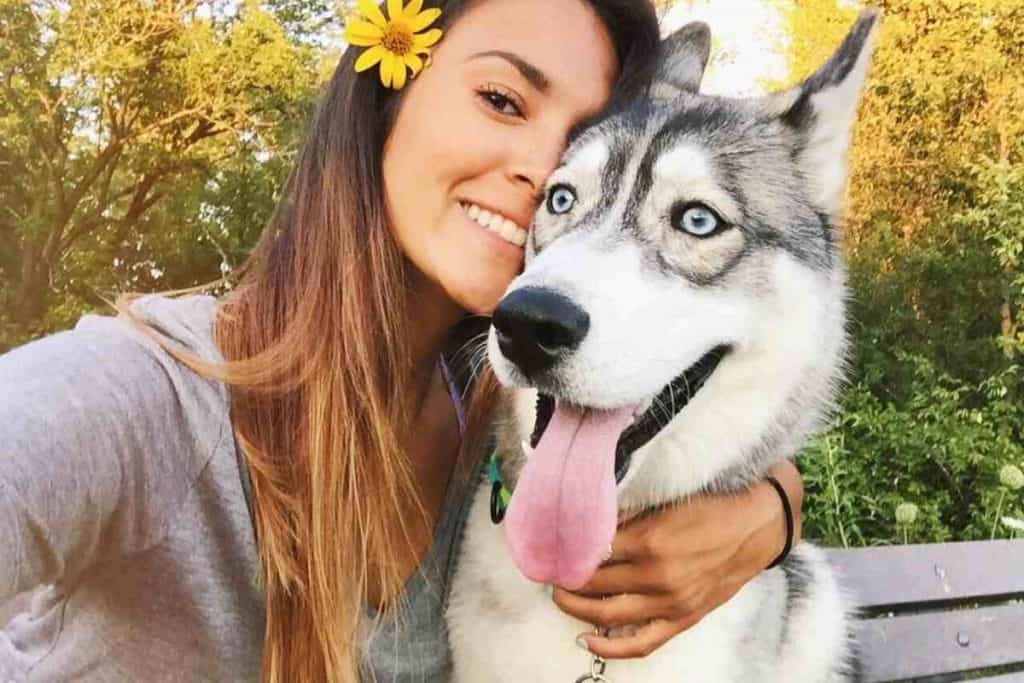
You should give your appropriate Husky toys and teething devices during this time. Also, you need to teach your Husky puppy that is nipping and biting people and other animals; this is not allowed.
If you have another dog in the house during the time that your Husky puppy is teething, watch their playtime. Sometimes these play nips, and bites can turn into a severe fight.
Socializing Your Husky Puppy
It is always best to start to socialize your Husky puppy early. This is probably one of the most important parts of caring for your Husky.
Socialization should begin around eight weeks of age.
Most people will usually start with puppy classes. This is a great way that you can get your Husky puppy around other puppies.
During your Husky puppy first few months of life, you need to introduce them to many different sounds and environments. Puppy classes will allow your puppy to learn many of the basic commands such as sit, lay down, and stay as well as how to walk on a leash without pulling.
During this time, it is always recommended that your Husky experience different types of social environments involving people and other dogs.
Without this proper Socialization and training, your Husky puppy may be afraid in certain situations, such as with new people or animals.
When training your Husky puppy, think of all conditions that they may have to encounter in their life.
Your Husky puppy should be very relaxed around people, pets, cars, people on bicycles, honking horns, stairs, cats, exams by the vet, and in very large crowds of people.
If you can get your pet to get used to these situations will make for a much more relaxed life for you and your Husky.
Between two and four months old, your Husky is the most comfortable learning new behaviors, having new experiences, and meeting new people or animals.
They may still be scared, but you can help them by taking them very often to new places and around new people.
Also, provide positive reinforcement when they behave appropriately and support them if they are afraid.
After your Husky is four months old, they are less tolerant of learning to adapt to new surroundings and people or animals. This can make training an older Husky more difficult.
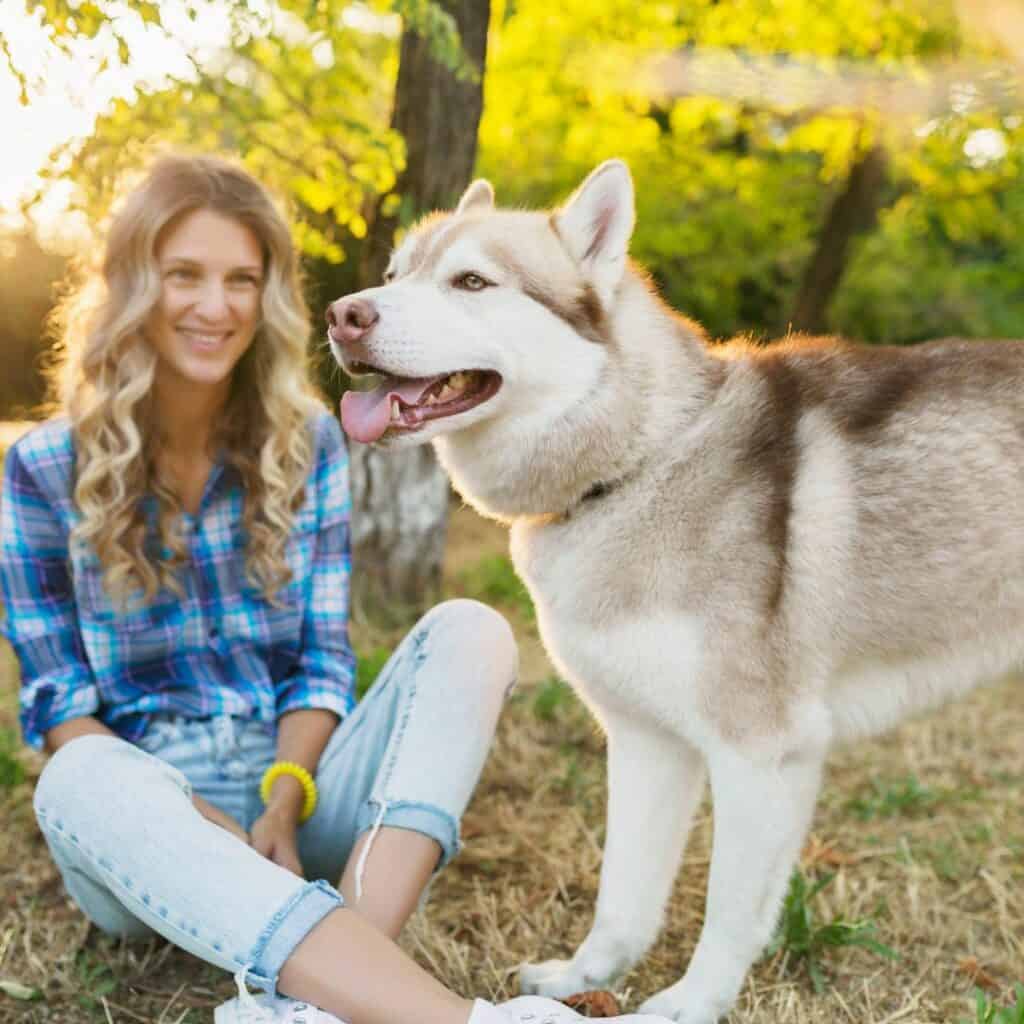
Signs of Illness in Your Husky
When your Husky is young, they are very susceptible to diseases and illnesses. Some diseases can be very serious, and many times are 100 % preventable.
Therefore, you need to make sure that your Husky receives all the vaccines they required.
These vaccines alone will not prevent every disease. You will also need to watch your Husky puppy for any signs of Illness.
You need to take your Husky puppy to the vet as soon as possible if you see any of these signs:
- Not eating
- Not gaining weight
- Vomiting
- Swollen and painful stomach
- Coughing
- Lethargic
- Diarrhea, with or without blood
- Discharge from their nose
- Trouble breathing
- White gums
- Red, swollen eyes, with or without discharge
- Not able to pee or poop
These signs can mean something is wrong and need vet attention as soon as possible.
Contact your veterinarian if you see any of these common signs or symptoms. They can advise you on what to do next and if they should see your dog.
Grooming your Husky
Your Husky will shed a lot. One way to reduce their shedding is by brushing them daily. A husky has a “double-coat,” meaning that they have a thick undercoat and a topcoat.
This thick coat is needed to keep them warm in the winter and cool in the summer months. Once or twice a year, your Husky will shed their undercoat.
During this time, if you will brush them more often, it will help keep the fur off your floor.
A Husky is a breed that can benefit from the use of a Furminator. These brushes are used to remove the dead hair of the undercoat.
Recommended Reading on Huskies
- Husky Puppies – How To Take Care Of A Husky Puppy
- Husky Pups – Teething, Biting, and Chewing
- Husky Temperament: What’s it Like Owning One?
- Huskies as Pets: Costs, Life Expectancy, and more
- Are Huskies Good with Kids? A Guide for Parents
- How big do Huskies get? (Plus size info for Husky mixes)
- 5 Factors Affecting How Much Huskies Costs
- Husky Rescue Guide
- At What Age Do Huskies Stop Growing?
- The Ultimate Guide to What Huskies Can (And Can’t) Eat
- How to Get Huskies to Calm Down (Answered!)
Final Thoughts
Huskies can be fun-loving pets, but there are certain things that you need to do to make sure that they are started on the right foot as far as keeping them healthy.
As soon as you get your new Husky puppy, having a vet check them over and look at their vaccine history is best.
This way, you can ensure that your Husky puppy gets started with the necessary prevention to keep them healthy and happy.
Husky Puppy: Frequently Asked Questions
What Are The Different Types Of Huskies?
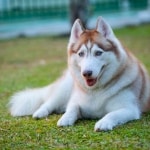
There are four main types of huskies: Siberian Husky, Alaskan Husky, Mackenzie River Husky, and the Greenland Husky. Each type has unique characteristics, such as size, coat color, and temperament. Siberian Huskies are the most common type of husky and are known for their friendly and outgoing personalities. Alaskan Huskies are bred for sled racing and are highly athletic. Mackenzie River Huskies are larger and stronger than other types of huskies, while Greenland Huskies have thick coats and are well-suited for cold climates.
How Can I Adopt A Husky Puppy?

There are many ways to adopt a husky puppy. One option is to look for reputable breeders in your area. Another option is to visit animal shelters and rescue organizations. It is important to do your research and find a reputable breeder or organization to ensure that the husky puppy is healthy and well-cared for.
Are Huskies Good House Dogs?
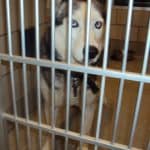
Huskies can make great house dogs, but they require a lot of exercise and attention. They are highly energetic and need plenty of space to run and play. Huskies also shed a lot, so regular grooming is necessary to keep their coats healthy and clean.
Are Huskies Easy To Train?
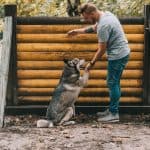
Huskies can be stubborn and independent, which can make them challenging to train. However, with patience and consistency, they can learn a variety of commands and tricks. Positive reinforcement training methods, such as clicker training and treat rewards, can be effective for training huskies.
What Is The Typical Lifespan Of A Husky?
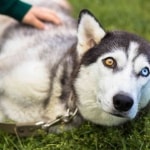
The average lifespan of a husky is between 12 and 15 years. However, this can vary depending on the individual dog’s health and lifestyle. Proper nutrition, regular exercise, and routine veterinary care can help ensure a long and healthy life for your husky.
At What Age Is A Husky No Longer Considered A Puppy?
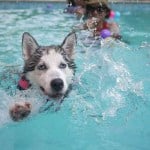
Huskies are considered puppies until they are around 1 year old. After that, they are considered adults and may continue to grow and mature until they are around 2-3 years old. It is important to provide proper training and socialization during the puppy stage to ensure that your husky grows up to be a well-behaved and happy adult dog.

